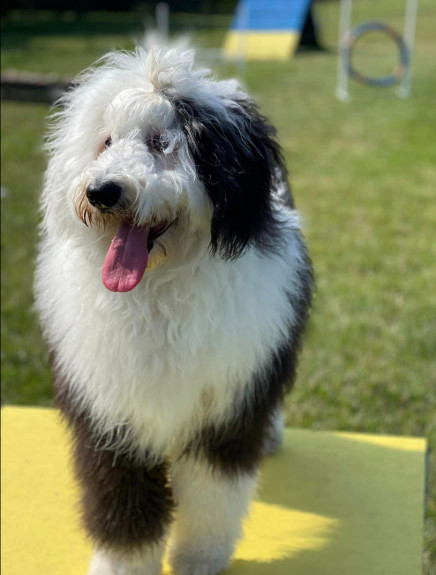The Noodle Connection: Aspiring therapy dog Noodle the Doodle is already making connections at HU and beyond

Like other faculty members at Huntington University, Dr. Nicole Scheiman keeps her door open during her office hours. In one respect, however, her open door in Dowden Science Hall is quite different than a door leading to any other faculty office: Scheiman’s has a pet gate.
Visit Scheiman’s office on the right day, and a black and white sheepadoodle sporting a stylish yet functional hair bow or two will greet you at the door. At less than a year old, she is still growing, but someday this young puppy could reach a mature weight of approximately 80 pounds. And someday, if all goes according to plan, she will be a certified therapy dog.
Her name is Noodle.
Noodle the Doodle reported for her first day of work at Huntington University on January 13, 2023. Since then, she has acquired a celebrity status that only a dog can achieve.
“Usually if I don’t bring her,” Scheiman said, “I hear, “Oh, Noodle’s not here?’”
Coming to campus a few days a week is part of Noodle’s therapy dog training. Her current “job responsibilities” include attending Scheiman’s classes and meetings, where she is learning to sit quietly in the background (a tough job for an excited puppy, but she manages it well). She is also getting used to campus and the variety of new things she can experience there.
“The best way to train her is bringing her here,” said Scheiman, who is the director of HU’s occupational therapy assistant bachelor’s degree program. “Interacting with people. That’s the best training for them [therapy dogs], to absolutely immerse them in anything they may encounter.”
Scheiman is hoping that Noodle will be ready to take the certification test in 2024, at which point Noodle will be able to continue her work on campus as well as work in therapy settings. Until then, Noodle is still a student “studying” for her upcoming exam.
The certification test will require Noodle to demonstrate that she can remain calm even in the midst of stressful or chaotic settings. Although the specifics vary by test provider, it is common for dogs to test in a loud environment, with kids, in a busy crowd, and around crutches, wheelchairs, and walkers, equipment that they would encounter in a hospital setting. Through it all, they must demonstrate that they will “attend to” (pay attention to and obey) their handler. Noodle will need to attend to Scheiman.
She will be eligible to take the certification test after she is more than one year old. After that benchmark, when Noodle takes the test will be Scheiman’s choice.
“There’s a lot of training, a lot of time, a lot of patience,” said Scheiman.
Passing the certification test is the only official step required to become a certified therapy dog, but Noodle is undergoing training at an obedience school to make sure she is in top shape for the test. Her first formal training was in general obedience. Next, she will train in canine good behavior.
Scheiman is actively involved in the training. As Noodle’s handler, she wants Noodle to be used to working with her. Taking the time now to build trust will pay off later when they are working together in clinical and classroom settings.
“It takes time to build confidence and trust. She has to build confidence and trust in me, that I will always make sure her needs are met and she’s not put in a bad way.”
Noodle is also learning to connect with and trust the Huntington University students she encounters. Occupational therapy assistant students are learning firsthand about animal-assisted therapy, and Noodle serves as a stress reliever for those who need it, a comfort for those who are homesick, and a conversation starter for those who walk her.
“If a shy student walks Noodle around campus, they’re going to meet other students,” said Scheiman. “No doubt about it. If I walk her across campus, I always allow extra time because there’s going to be students coming over. And that’s the point — that’s the goal. Then the students meet each other; she’s kind of a connector. I think therapy dogs connect people.”
Scheiman is careful to ensure that students are comfortable around Noodle. She always provides ways for students to let her know if they are uncomfortable with having Noodle in class.
“I’ve never had anyone not want to be around her. They enjoy her — it’s a break.”
Noodle’s breed could have something to do with her popularity. Her size and playfulness are well-suited for children in particular. She also enjoys giving hugs, has thick hair that doesn’t shed, and can even wear clothes. These traits make her ideal for children practicing skills of daily living such as brushing hair and getting dressed.
“A child could learn to dress Noodle, learning those skills. If they’re having trouble with fine motor [skills], they could put a shirt on Noodle and button her shirt.”
Noodle’s weight will also be an advantage.
“With kids, we’ll often put weighted therapy vests on them to have that calming effect. It’s kind of like the weighted blankets you see now. Her sitting on a child’s lap would be calming to them.”
Even for visitors to Scheiman’s office who don’t consider themselves dog people, there is something fun about meeting Noodle in one of the last places you’d expect to find a dog. There’s also something comforting about sitting with her, a fellow living creature who is free from the burdens that humans carry. Dogs listen if you want to talk. If you don’t, they sit with you or play with you. No questions asked.
The connection that humans feel with dogs is a reason why animal-assisted therapy is important to occupational therapy practitioners like Scheiman.
“This is another tool in our toolbox to achieve the goals we’re looking to achieve. Because people will do things for dogs that they won’t always do for therapy practitioners. They’re very motivating.”



